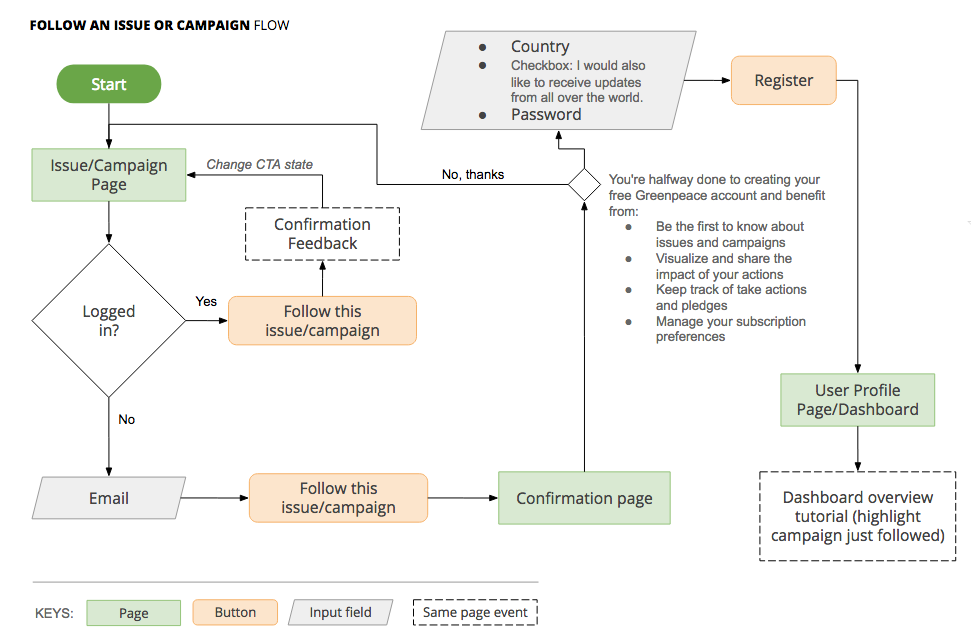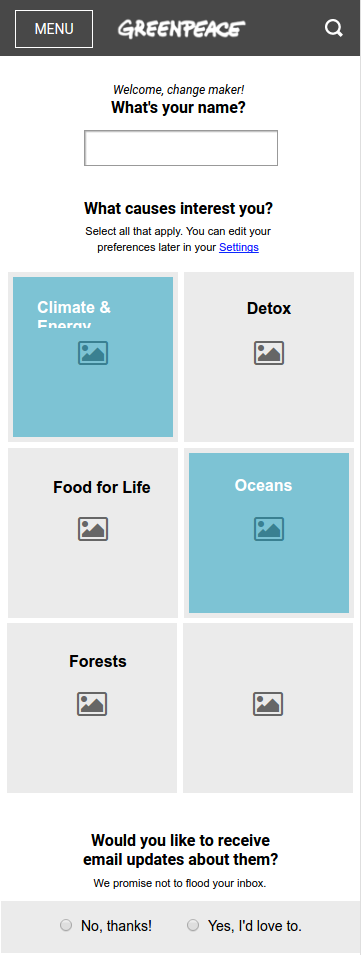Planet 4 Looking Forward
Table Of Contents:
Version 2 (V2): P4 MLP
V3: Personalisation: Give more User Control
V4: Visualizing Impact: Show us the data
V5: Let’s get social: We all want a better world
V6: Let’s get local: Charity begins at home
V7: UGC + Content Federation
Re-establishing priorities
The P4 team is working towards enabling Greenpeace to better measure impact and engage our supporters. As the first FOSS (free and open source software) project for the organization, we have had many successes, also recently celebrated by our dev partner. P4 is a layer on top of WordPress, and we hope our work is contributing back to the WordPress community, experimenting an innovative infrastructure on Kubernetes. We’ve created an easy-to-use, modular backend system for the 150+ web editors at Greenpeace. By the time this month is over we’ll have launched Planet 4 in eight (and counting!) National and Regional Offices (check which ones). And we’ve done it all using open methodologies, tight timelines and a very small team.
The Planet 4 Concept that we are aiming to achieve is a blue sky vision of what Greenpeace could do with this platform. This high-level roadmap attempts to explain contingencies that make it more or less easy to build this software, representing the future phases of the P4 project. We’ve grouped feature sets to help us focus.
We need YOUR help. As an open source project, there are tons of ways to contribute, and we’d love to hear from you. Come to our monthly Community Call or just reach out.
Version 2 (V2): P4 MLP

The P4 prototype was improved over the last few months, with the team focusing on rollouts to offices worldwide, solving technical debt and mapping out the next few months. While still working to deploy the “out of the box” P4, improve Shortcake blocks (super-welcomed by the editors’ community!) and bug-fixing. It is now time to switch back to overall product development, embracing our Version 2, which will lead P4 to its Minimum Viable Product version.

The big, new engagement feature Version 2 will include is what we call the Follow Feature. We want to give supporters the ability to pick and choose which stories and information they get from Greenpeace. When a user logs in, they will have the ability to “follow” a particular issue or even a specific campaign. This provides help filtering through the work Greenpeace does around the world.

To make this work, we need to build a login and user dashboard for supporters, implying that we have to figure out how we will privately and securely store user data, giving logged-in users full control over their preferences and data. We want it to be easy to follow/unfollow issues or campaigns, receive specific updates about individual impact within a broader scope or get notified about new actions available to support Greenpeace work.
V3: Personalisation: Give more User Control

Once the login and follow feature ships, we aim to deepen engagement. With limited integration with CRMs, we will provide more control for Greenpeace supporters. We will design the Activist Dashboard to manage sharing this data with Greenpeace. We’ll give users total control over their information by letting them choose what/when to share. We aim to surface any moments where a user might share personal information in humane, easy to read language.
Users will be able to update contact preferences, personal information, donation settings and more in the Activist Dashboard. Furthermore, users will be able to see what actions they have participated in, petitions they’ve signed and donations they’ve made.
The dashboard could include an “Action List”, allowing users to save and share actions they find interesting. Think of it as a recipe box for activism — what recipes can Greenpeace give supporters?
So we need to identify what kinds of user information we can explore in the short, medium and long term. We also need to design integrations with the tools and systems we currently use to make that possible.

V4: Visualizing Impact: Show us the data
Once we have a space to show our supporters their data, we want to further deepen engagement, opening our work up for a more thoughtful exploration of campaigns. We can explore unique ways to show impact, but to achieve this part of the vision, we have a lot of work to do.
Greenpeace needs to define what we mean when we say “impact” and identify metrics that help us measure it. We need to identify a few practical methods from existing campaigns, and use this insight in Planet 4. Looking at integrations with planning tools might be a smart place to start. We’ll be looking across the organization for help.

What do we need to do in our processes to ensure that we are documenting global impact? How do we allow our technology to show this impact to supporters? How can we visualize individual impact and add personalisation to our Activist Dashboard?
These are big questions. We’ll need to rally and coordinate across the organisation to answer them, working with folks from the tech lab, insights, open engagement, fundraisers, campaigners, action tech community and more to participate. Planet 4 will hopefully inspire Greenpeace to become the data savvy non-profit we know it can be. We can show supporters how we’re reaching our goals, we just need to figure out how!

V5: Let’s get social: We all want a better world
We have the power to influence the people around us. In this future version of the engagement platform, we want to build more social features. These will allow users to organize and advocate on behalf of the planet. Greenpeace currently uses a custom built volunteering platform called Greenwire. We will look into a potential integration and expand features to allow environmentalists to self organize. They will be able to connect with each other, teach each other and support each other.

We pushed this group of features to a later version because we need to understand what kind of social engagement Greenpeace supporters want and need. Changing the world is more fun with other people and that community development is important. We will work with supporters, social media mavens, mobilisation experts and volunteer coordinators to define what these features are. What does our audience need?
Greenpeace doesn’t aim to circumvent established social networking technologies, but to help people act. We’ve no wish to become a social networking platform for social networkings sake. Instead, we want to offer people a safe place to learn, grow and find ways to participate in building a better tomorrow.
V6: Let’s get local: Charity begins at home
We also want to help people find local ways to engage. We’ve pushed geo-locative features into Version 6 because we have a lot to do! That’s not to say we won’t revisit this decision as we go. However, first concentrating on the initial social features felt more manageable.
V7: UGC + Content Federation
And out there on the cusp of reality are speculative features that we would like to build. Content federation across the global organization, user generated content (from the front end), and Greenpeace e-commerce are things that crossed our mind and got put into the “someday” category.
Re-establishing priorities
If you’ve been paying attention to the Planet 4 project, you’ll already know — nothing is set in stone. We are releasing early and often and building software for an evolving organization. We are aiming at a moving target, which means your contribution can influence more than you think.
What features do YOU think Planet 4 needs? Let us know!